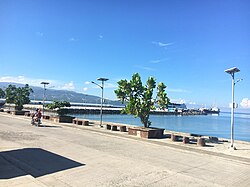
Back بايباي Arabic Baybay, Leyte BCL Baybay CBK-ZAM Baybay CEB Baybay German Baybay EO Baybay French Baybay ID Baybay, Leyte ILO Baybay Italian
Baybay | |
|---|---|
| City of Baybay | |
 Port area of Baybay | |
| Motto: Our City. Our Home. Our Future | |
 Map of Leyte with Baybay highlighted | |
Location within the Philippines | |
| Coordinates: 10°41′N 124°48′E / 10.68°N 124.8°E | |
| Country | Philippines |
| Region | Eastern Visayas |
| Province | Leyte |
| District | 5th district |
| Founded | 1620 |
| Chartered | 1910 |
| Cityhood | June 16, 2007 (Lost cityhood in 2008 and 2010) |
| Affirmed Cityhood | February 15, 2011 |
| Barangays | 92 (see Barangays) |
| Government | |
| • Type | Sangguniang Panlungsod |
| • Mayor | Jose Carlos L. Cari |
| • Vice Mayor | Ernesto M. Butawan |
| • Representative | Carl Nicolas C. Cari |
| • City Council | List |
| • Electorate | 70,431 voters (2022)[1] |
| Area | |
• Total | 459.30 km2 (177.34 sq mi) |
| Elevation | 147 m (482 ft) |
| Highest elevation | 1,313 m (4,308 ft) |
| Lowest elevation | 0 m (0 ft) |
| Population (2020 census)[5] | |
• Total | 111,848 |
| • Households | 28,135 |
| Demonym | Baybayanon |
| Economy | |
| • Income class | 1st city income class |
| • Poverty incidence | 26.02 |
| • Revenue | ₱ 1,101 million (2020) |
| • Assets | ₱ 4,073 million (2020) |
| • Expenditure | ₱ 673.7 million (2020) |
| Service provider | |
| • Electricity | Leyte 4 Electric Cooperative (LEYECO 4) |
| Time zone | UTC+8 (PST) |
| ZIP code | 6521 |
| PSGC | |
| IDD : area code | +63 (0)53 |
| Native languages | Baybay Cebuano Tagalog |
| Website | baybaycity |
Baybay (IPA: [baɪ'baɪ]), officially the City of Baybay (Cebuano: Dakbayan sa Baybay; Waray: Syudad han Baybay), is a component city in the province of Leyte, Philippines. It has a population of 111,848 people.[5]
With an area of 45,934 hectares (460 km2; 180 sq mi), it is the second largest city in the province after Ormoc. Formerly, Baybay was the biggest town in Leyte in terms of population and second in terms of land area, after Abuyog. The Baybay language, a Visayan language distinct from both Waray and Cebuano, is spoken in the city itself.[8]
Baybay houses a major port on the central west coast of Leyte, where ferries leave for and from Cebu and other islands. It has also the Baybay Public Terminal, serving routes from Tacloban, Ormoc, Maasin, Manila, Davao City, and other towns in Leyte, Southern Leyte, and Samar.
Generally an agricultural city, the common means of livelihood are farming and fishing. Some are engaged in hunting and in forestal activities. The most common crops grown are rice, corn, abaca, root crops, fruits, and vegetables. Various cottage industries can also be found in Baybay such as bamboo and rattan craft, ceramics, dress-making, fiber craft, food preservation, mat weaving, metal craft, and Philippine furniture manufacturing and other related activities.
It is the home of the Visayas State University, one of the leading schools in Southeast Asia on agricultural research, and was called as "Resort University."[9]
- ^ Commission on Elections [dead link]
- ^ City of Baybay | (DILG)
- ^ "2015 Census of Population, Report No. 3 – Population, Land Area, and Population Density" (PDF). Philippine Statistics Authority. Quezon City, Philippines. August 2016. ISSN 0117-1453. Archived (PDF) from the original on May 25, 2021. Retrieved July 16, 2021.
- ^ https://elevation.maplogs.com/poi/baybay_city_leyte_philippines.524452.html.
{{cite web}}: Missing or empty|title=(help) - ^ a b Census of Population (2020). "Region VIII (Eastern Visayas)". Total Population by Province, City, Municipality and Barangay. Philippine Statistics Authority. Retrieved July 8, 2021.
- ^ Highlights of the 2015 Census Results for the city of Baybay psa.gov.ph
- ^ "PSA Releases the 2021 City and Municipal Level Poverty Estimates". Philippine Statistics Authority. April 2, 2024. Retrieved April 28, 2024.
- ^ Carl Rubino. 2005. Utudnon, an Undescribed Language of Leyte Archived May 13, 2015, at the Wayback Machine. In Hsiu-chuan Liao and Carl R. Galvez Rubino (eds.), Current Issues in Philippine Linguistics and Anthropology: Parangal kay Lawrence A. Reid, 306-336. Manila, Philippines: Linguistic Society of the Philippines and SIL Philippines.
- ^ "Welcome to the City of Baybay". www.vigattintourism.com. Retrieved January 29, 2019.



